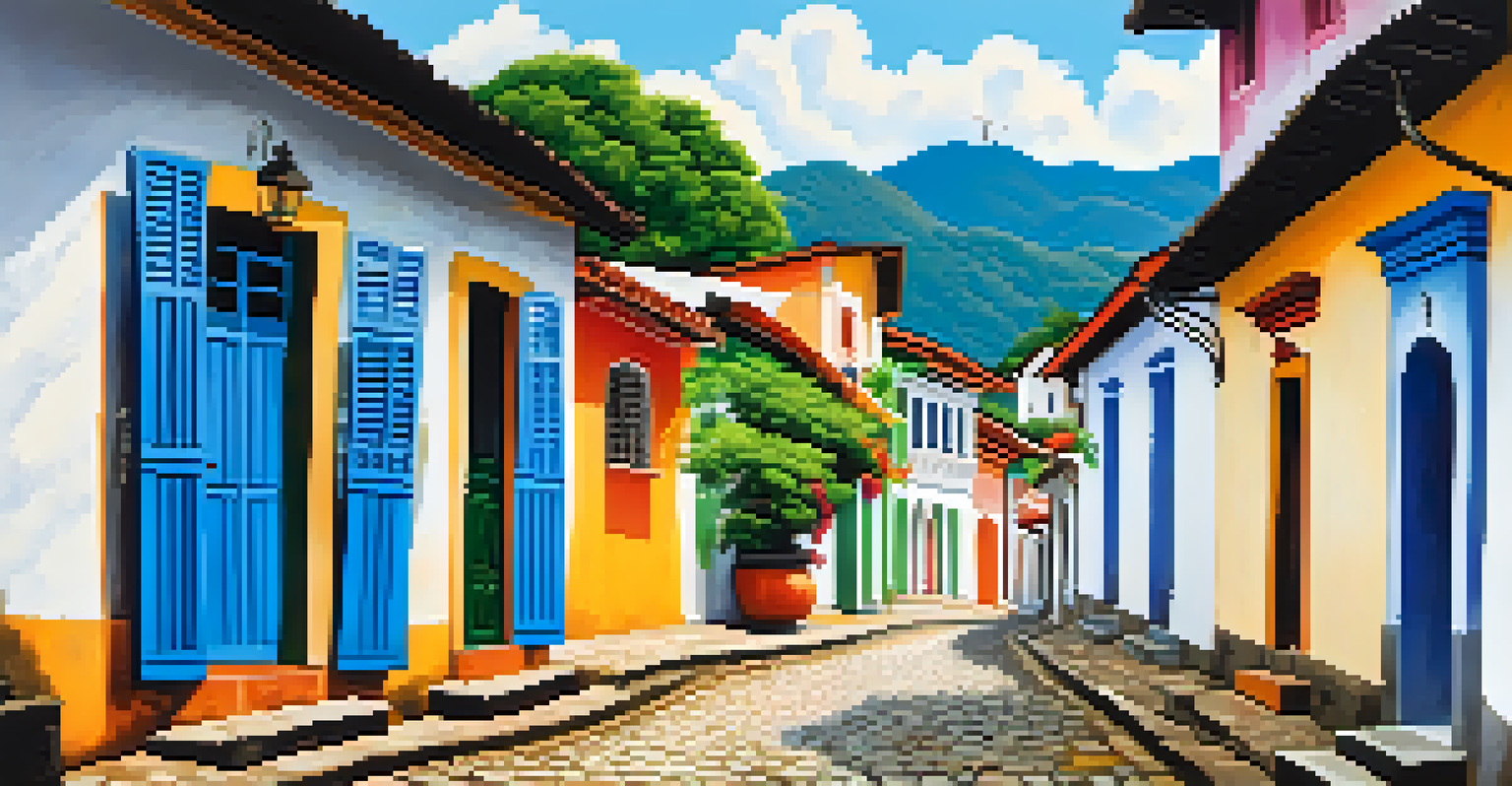The Architectural Wonders of Brazil's Colonial Towns

A Glimpse into Brazil's Colonial Past
Brazil's colonial towns are like time capsules, preserving the essence of the country's rich history. Established during the 16th to 18th centuries, these towns showcase the fusion of European, African, and Indigenous influences. Each town tells a unique story through its architecture, reflecting the diverse cultures that have shaped Brazil.
The past is never dead. It's not even past.
As you stroll through the cobblestone streets, you’ll notice the colorful facades and intricate details that define this architectural style. The buildings often feature baroque elements, characterized by ornate decorations and grandiose designs. This blend of styles results in a captivating visual narrative, inviting visitors to explore and appreciate the artistry of the past.
These towns are not just about aesthetics; they hold significant historical importance. They served as vital economic and cultural hubs during the colonial era, contributing to Brazil's development. Understanding the context behind these architectural wonders enriches the experience of visiting them.
The Charm of Ouro Preto
Ouro Preto, a UNESCO World Heritage Site, is often regarded as the crown jewel of Brazil's colonial architecture. Nestled in the mountains of Minas Gerais, this town is famous for its stunning baroque churches, like the Church of Saint Francis of Assisi. The church's intricate facade and beautiful interior are a testament to the artistic prowess of the time.

Walking through Ouro Preto feels like stepping back in time, with every corner revealing beautifully preserved colonial buildings. The town's layout, with its steep hills and winding streets, adds to its charm, making it a delightful place to explore on foot. As you wander, you can almost hear the whispers of history echoing through the streets.
Brazil's Colonial Towns Showcase History
Brazil's colonial towns blend European, African, and Indigenous influences, preserving the rich history and diverse cultures of the country.
The town is also home to numerous museums that showcase its rich mining history. These institutions help visitors understand the significance of Ouro Preto during Brazil's gold rush, highlighting how architecture and economy went hand in hand. It's a perfect blend of history, culture, and stunning visuals.
The Allure of Paraty
Paraty, another UNESCO World Heritage Site, is renowned for its well-preserved colonial architecture and stunning natural surroundings. The town is characterized by its whitewashed buildings and colorful doors, creating a picturesque scene that draws visitors from around the globe. The historic center, with its charming cobblestone streets, is a delight to explore.
Architecture is the learned game, correct and magnificent, of forms assembled in the light.
The architectural style of Paraty reflects the influence of both Portuguese settlers and the local environment. The town was once a significant port during the colonial period, serving as a hub for gold and other goods. This historical significance is still visible in the architecture, which blends practicality with beauty.
In addition to its stunning buildings, Paraty is famous for its cultural festivals and vibrant arts scene. Events like the Paraty Literary Festival attract writers and artists, further enriching the town's cultural tapestry. This combination of history, architecture, and culture makes Paraty a must-visit destination.
The Historical Significance of Salvador
Salvador, the first capital of Brazil, is a vibrant city that showcases a blend of colonial architecture and Afro-Brazilian culture. The Pelourinho neighborhood, with its colorful buildings and cobblestone streets, is a UNESCO World Heritage Site. This area is a living museum, reflecting the architectural styles and cultural influences that have shaped the city over centuries.
The town's churches, such as the Cathedral of Salvador, are remarkable examples of colonial architecture. Their intricate designs and historical significance draw visitors eager to learn more about Brazil's past. The mix of baroque and neoclassical styles in these buildings provides insight into the artistic movements of the time.
Key UNESCO Heritage Sites
Towns like Ouro Preto and Paraty highlight the stunning colonial architecture and cultural significance, attracting visitors from around the world.
Salvador's cultural heritage is also evident in its music, dance, and cuisine, making it a dynamic place to visit. The architecture serves as a backdrop to the lively street performances and festivals that celebrate Afro-Brazilian traditions. This rich cultural experience enhances the appreciation of Salvador's architectural wonders.
The Unique Features of São João del-Rei
São João del-Rei is a lesser-known gem that offers a unique glimpse into Brazil's colonial architecture. The town is famous for its baroque churches, particularly the Church of Saint Francis of Assisi, which features stunning gold-leaf interiors. This church, along with others in the area, exemplifies the skill of local artisans who contributed to its creation.
The historic center of São João del-Rei is filled with charming buildings that reflect the town's colonial past. Walking through its streets is a peaceful experience, allowing visitors to appreciate the artistry and craftsmanship of the era. The town's tranquil atmosphere makes it a perfect spot for those looking to escape the more tourist-heavy destinations.
São João del-Rei is also known for its rich musical heritage, particularly the traditional music that resonates through its streets. The connection between the town's architecture and its cultural expressions adds depth to the visitor experience. Exploring this town reveals the intricate relationship between history, architecture, and local traditions.
The Artistic Legacy of Diamantina
Diamantina is a town that captivates with its stunning landscapes and colonial architecture. Nestled in the mountains of Minas Gerais, it boasts a rich history linked to diamond mining. The town's architecture reflects its wealth during the colonial era, with grand mansions and ornate churches that tell the story of its prosperous past.
The Church of Our Lady of the Rosary is a standout, showcasing intricate baroque details and a stunning altar. This church, along with others in Diamantina, highlights the town's artistic legacy and the craftsmanship of its builders. The architectural beauty is complemented by the scenic backdrop of the surrounding hills, creating a picturesque setting.
Importance of Preservation Efforts
Preserving Brazil's architectural heritage is vital for maintaining cultural identity and history, with tourism playing a key role in supporting these initiatives.
Diamantina's vibrant cultural scene, including music and festivals, further enhances the experience of visiting. The town hosts various events that celebrate its history and traditions, allowing visitors to immerse themselves in the local culture. This combination of architecture and cultural richness makes Diamantina a fascinating destination.
The Majestic Churches of Mariana
Mariana, one of the oldest towns in Brazil, is renowned for its majestic churches and colonial architecture. The town is home to the stunning Cathedral of Mariana, which features impressive baroque architecture and intricate details. This cathedral serves as a testament to the town's historical significance and architectural grandeur.
As you wander through Mariana, you'll encounter several other beautiful churches that showcase the town's rich religious heritage. Each church has its unique charm, with ornate altars and beautiful paintings that reflect the artistic talent of the era. This architectural diversity provides a fascinating insight into the spiritual life of the colonial period.

Mariana's well-preserved colonial streets and historic buildings create an inviting atmosphere for visitors. The town offers a peaceful escape, with ample opportunities for exploration and discovery. The combination of stunning architecture and serene surroundings makes Mariana a must-visit destination for anyone interested in Brazil's colonial history.
Preserving Brazil's Architectural Heritage
The architectural wonders of Brazil's colonial towns are not just beautiful; they are vital pieces of the country’s cultural heritage. Preservation efforts are crucial to maintaining these historical sites for future generations. Local governments and organizations work tirelessly to ensure that the unique architecture and history are protected from modern development.
Tourism plays a significant role in these preservation efforts, as it raises awareness and funds for restoration projects. By visiting these towns, tourists contribute to the local economy and help maintain the charm that draws them in. It’s a beautiful cycle where appreciation leads to preservation, ensuring that these architectural gems continue to inspire.
As we explore these towns, it’s essential to respect their history and understand the significance of what we see. Engaging with local communities and participating in cultural events enhances the experience and fosters a deeper connection to the heritage. Together, we can help preserve Brazil's architectural wonders for generations to come.